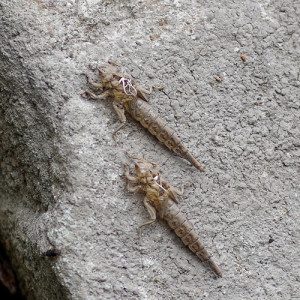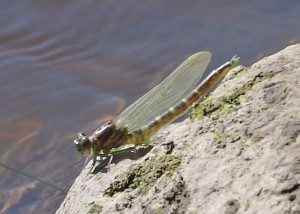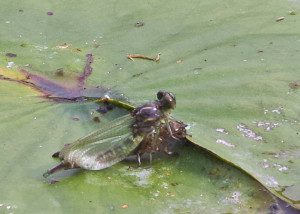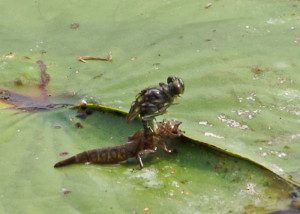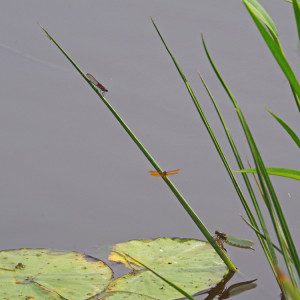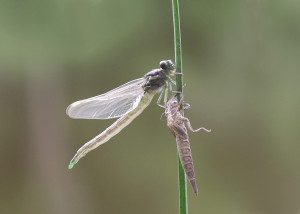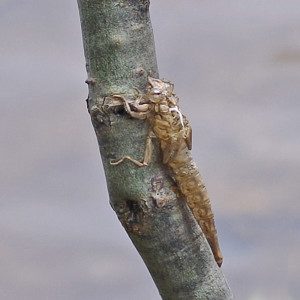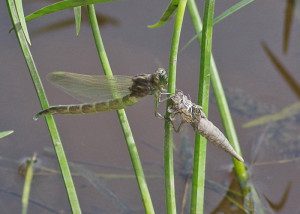Salutations, BugFans,
The story begins on the river, two years ago, with flat, tan, elongated exuviae clinging to rocks and vegetation at the water’s edge (the BugLady didn’t know then, but she suspected, that the large, pale tenerals that flew from the ground, straight up into the trees, were part of the story, too).
Arrow clubtail exuviae, said BugFan Bob. Arrow clubtail?
Is the Arrow clubtail rare? Is it new to the area? No and no (though the BugLady was new to the park and to the species). The hunt was on.
Arrow clubtails are in the order Odonata and the Clubtail family, Gomphidae, which includes dragonflies with grand names like dragonhunter, snaketail, spinyleg, and sanddragon. According to Paulson, in Dragonflies and Damselflies of the East, “alert and fast-flying, many of them rare, local, and with brief flight seasons, clubtails are considered the most exciting group by many dragonfly enthusiasts” Here’s why: http://bugguide.net/node/view/652602/bgpage,http://bugguide.net/node/view/179632/bgpage, http://bugguide.net/node/view/234318/bgpage, http://bugguide.net/node/view/397702/bgpage, http://bugguide.net/node/view/892545/bgimage, and http://bugguide.net/node/view/262939/bgimage. Paulson goes on to say that “despite their great diversity and local abundance, their behavior is very poorly known.”
Clubtails get their name from the three, variously-flared segments that form a noticeable “club” at the end of the abdomen of many (but not all) species. The club is more prominent in males, and they will raise the end of the abdomen to display it, even in flight. Most clubtails are medium-sized – about 2” to 2 ½” long – with unspotted wings and with striped bodies that use the zebra’s strategy of disruptive coloration as camouflage. What Clubtails have in common is that their eyes (usually green, blue or gray) do not touch each other on the tops of their heads like those of most other dragonflies.
There are about one hundred species north of Mexico (900 world-wide), and they generally prefer well-oxygenated, running water rather than still. Lacking an ovipositor, the female releases eggs by tapping the tip of her abdomen on the water, unguarded by the male. The eggs overwinter and hatch when the water warms in the next spring; depending on water temperature, they may live underwater as naiads for several years. Stocky, young Gomphids are ambush predators, burrowing shallowly into the substrate, lurking with only their eyes exposed (the better to see you with, my dear) and the tip of their abdomen (for breathing).
[Sidebar – when the BugLady first took entomology, oh-so-long ago, the immature stage of insects that practiced Complete metamorphosis (egg to larva to pupa to adult – flies, beetles, wasps, etc.) were called larvae. Immatures of terrestrial insects with Incomplete metamorphosis (that hatch looking like their elders and add reproductive equipment and (usually) wings as they grow – true bugs, grasshoppers, etc.) were called nymphs, and immatures of aquatic species with Incomplete metamorphosis were called naiads. This distinction was espoused a century ago by the great Cornell entomologist John Henry Comstock (in whose Hall the BugLady studied bugs). Convention has relaxed in recent years and young Odonates are called all three, but old habits die hard.]
There were more exuviae in the summer of 2015 and a few in the first week of July, 2016. Then, on July 11, the BugLady saw a stubby, inch-high projection on top of a rock about six feet off shore. An emerging Arrow clubtail!! The BugLady’s zoom lens chose this moment to initiate a conversation about the Zen of focusing on small objects, resulting in an abundance of shots that are more “Close enough for government work” than they are “tack sharp.” Thanks to BugFan Freda for contributing a picture.
Arrow clubtails (Stylurus spiniceps) are “fairly-common/widespread-but-not-abundant” inhabitants of the northeast quadrant of the US. They prefer good-sized rivers with muddy/sandy bottoms and with trees along the edges. Unlike the “Pond clubtails” that the BugLady was chasing in spring (Ashy, Dusky, Lancet, Midland, Lilypad), the Arrow clubtail is a “Hanging clubtail,” one of 11 North American species in the genus Stylurus (“hanging” because of their tendency to perch on leaves that then bend down under their weight; they don’t really hang like darners).
Arrow clubtails are spectacular, both males http://bugguide.net/node/view/17871/bgimage and females http://bugguide.net/node/view/17869/bgimage. At 2 ½” long, they’re Wisconsin’s largest and longest Stylurus, and they’re unique in that the ninth segment of the abdomen is noticeably longer than the eighth.
Adults are strong flyers that dart out at their prey from perches and that may feed in the air. The reason the adults are tough to find is that they fly long patrols not far above the water’s surface (with their abdomen slightly tipped up), and then they go sit high up in a tree. Paulson describes the flight of a male patrolling his territory as interspersing a “hovering, bouncy flight that seems to have come from alternating fluttering and gliding, with extremely rapid, low, straight flight “like an arrow.” They are more active in late afternoon until dark.
Females deposit eggs in rapids or riffles areas but the naiads find more sluggish water for their development. When it’s time to assume an adult form, they crawl out of the water for only a short distance to do so (the BugLady found emerging Arrow clubtails after 3:00 PM; she hasn’t seen one crawl out of the water yet, but she has found several that didn’t have the strength to exit their skins). Immature/juvenile Arrow clubtails frequent the woods (for a “lengthy period,” says Paulson) until they are ready to breed.
On July 13, the BugLady found a dozen exuviae that had not been there two days earlier. And, she saw five emerged/emerging Arrow clubtails. And two more on July 16. It made her wonder if Arrow clubtail emergence might be loosely synchronized, so she moseyed through some of the literature and found some hints of synchronicity in related dragonflies, but nothing about the Arrow clubtail itself. In a report about dragonflies of the Canadian grasslands, Robert A. Cannings writes about the Elusive clubtail (Stylurus notatus) that “Experienced observers in Manitoba seldom see a mature adult, but sometimes lucky people have come across a mass emergence or thousands of exuviae on a river bank.” Another observer recorded an overnight appearance of 230 exuviae of a different clubtail genus on a 20 foot stretch of the New River in Virginia.
What would cause this phenomenon? One factor might be cold/rainy weather that stalls the naiads, allowing a large number to reach the point of emergence at the same time. Water quality and/or crowding have also been suggested. Large numbers of mature larvae (hellgrammites) of the totally un-related Dobsonfly (order Neuroptera) will emerge to pupate when stimulated by a thunderstorm. The BugLady also wonders about how the naiad decides where to pull out and emerge. How does it know that there will be trees nearby to shelter in (she generally finds exuviae on surfaces that are in the sun all day)?
The emerging dragonflies takes a short rest after pushing their head and “shoulders” out of their old skin, but then the abdomen slides out all at once. A teneral spends about 30 minutes lengthening and strengthening after it emerges, and then is capable of flight. On two occasions, the BugLady took a picture, looked down to check the image on the screen, and looked up to find the dragonfly gone. Their maiden flight, says BugFan Freda, “is amazingly strong,” and is preceded by a quivering of the wings (to warm up the flight muscles in the thorax). The BugLady observed one maiden voyage that ended at an altitude of about 25 feet, when the arc of the dragonfly’s trajectory intersected with that of an Eastern Phoebe.
The BugLady will keep walking the river, looking for adult arrow clubtails in their adult plumage (and enjoying the dancers, rubyspots, amberwings, whitetails and widows).
Maybe this’s what German poet Friedrich Schiller had in mind when he wrote “Ode to Joy” (Beethoven just put it to music).
Kate Redmond, The BugLady
Bug of the Week archives:
http://www4.uwm.edu/

